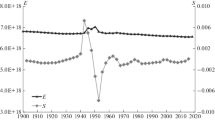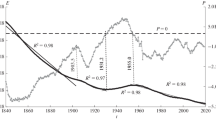Abstract.
Harmonic coefficients of the 2nd degree are separated into the invariant quantitative (the 2nd-degree variance) and the qualitative (the standardized harmonic coefficients) characteristics of the behavior of the potential V 2(t). On this basis the evolution of the Earth's dynamical figure is described as a solution of the time-dependent eigenvalues–eigenvectors problem in the canonical form. Such a canonical quadratic form is defined only by temporal variations of the harmonic coefficients and always remains finite, even within an infinite time interval. An additional condition for the correction or the determination of temporal variations of the 2nd degree is obtained. Temporal variations of the fully normalized sectorial harmonic coefficients are estimated in addition to ˙C¯ 20, ˙C¯ 21, and ˙S¯ 21 of the EGM96 gravity model. In addition, a non-linear hyperbolic model for C¯ 2m (t), S¯ 2m (t) is constructed. The trigonometric form of the hyperbolic model leads to the consideration of the potential V 2(ψ) instead of V 2(t) within the closed interval −π/2≤ψ≤+π/2. Thus, it is possible to evaluate the global trend of V 2(t), the Earth's principal axes and the differences of the moments of inertia within the whole infinite time interval.
Similar content being viewed by others
Author information
Authors and Affiliations
Additional information
Received: 25 September 1998 / Accepted: 28 June 2000
Rights and permissions
About this article
Cite this article
Marchenko, A., Abrikosov, O. Evolution of the Earth's principal axes and moments of inertia: the canonical form of solution. Journal of Geodesy 74, 655–669 (2001). https://doi.org/10.1007/s001900000127
Issue Date:
DOI: https://doi.org/10.1007/s001900000127




